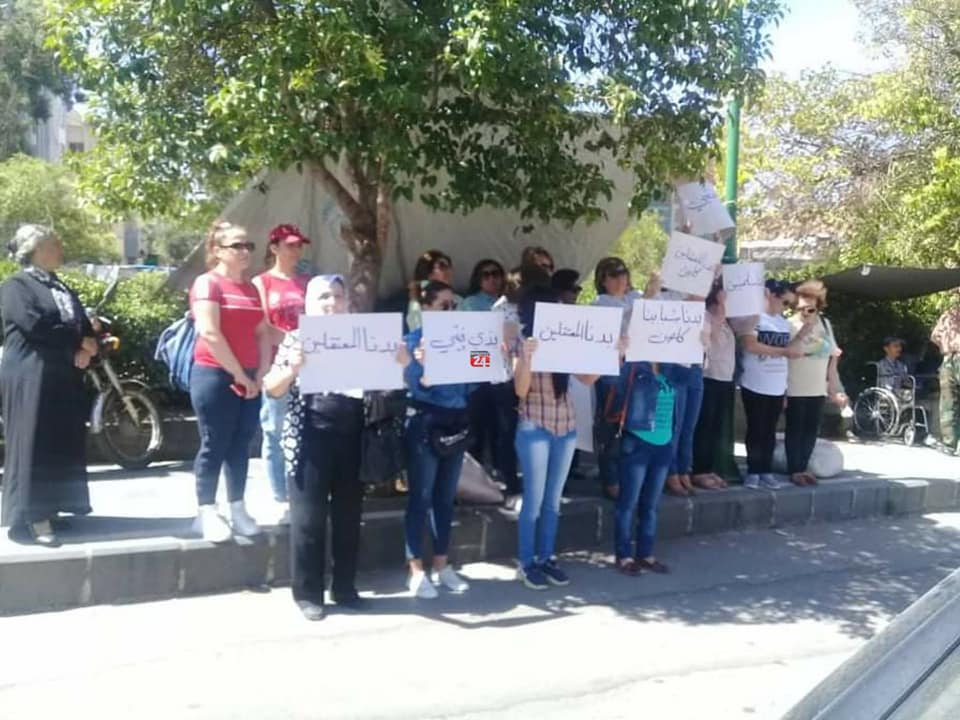The Suweida uprising sets itself apart from its predecessors through several distinctive features:
- It has unequivocally severed all ties with the Assad regime, swiftly transitioning from demands for improved living conditions and services to demanding political change, the implementation of Resolution 2254, and setting the nation on the path to renewal. It has presented itself as a continuation of the Syrian revolution that commenced in March 2011, upholding the early revolutionary slogans.
- Continuity: As it approaches its three-month mark, the protest has continued without pause. Demonstrators persistently occupy the streets and squares, both in the morning and evening, distinguishing it from previous protests led by the elite.
- Widespread Popular Participation: The uprising has seen broad participation encompassing all cities within the governorate, as well as most of its towns, involving individuals of all ages and genders. Notably, Bedouin tribes and various segments of society have joined the movement. Furthermore, our compatriots in Daraa have stood in solidarity with Suweida, even as the regime attempted to sow discord among these groups. In the face of these efforts to divide, they have remained united, chanting for freedom and dignity.
- Strong Women’s Participation: Women have played a significant role in this movement, and their extensive presence has had a positive impact on strengthening the uprising. This participation signals a potential vision of a future Syria characterized by modernity, democracy, and equality for all, without discrimination. The wide-ranging involvement of women in Suweida has garnered media attention and influenced the positions of certain Western countries that have expressed support for these protests.
- Commitment to Peacefulness: The protesters have steadfastly adhered to non-violence and have avoided provocation, even in the face of some criminal gangs associated with security services. Over three months, there have been no notable incidents of misconduct by the protesters. Not a single glass pane has been shattered, a rarity even in the world’s most esteemed societies. This underscores their respect for public and private property and their commitment to non-harm.
Key Achievements of the Suweida Uprising
Many have begun to ask, “What have three months of protests achieved? Has anything changed? What comes next? When will it lead to the regime’s downfall?” Upon careful review of these events, it becomes evident that this uprising has brought about significant changes. Suweida’s society is experiencing profound transformations as a result of this uprising, with achievements that manifest on both the national and local levels. The most noteworthy of these achievements include:
- Discrediting the Regime’s Minority Card: The regime can no longer exploit its narrative of protecting minorities to gain favour with the West. This falsehood no longer deceives anyone. Most Western countries now warn the regime against using violence against these peaceful, dignified protests. The protesters’ message resounds with the slogans of the Syrian revolution, demanding the implementation of UN resolutions.
- Renewed Hope: The uprising has restored hope to millions who took part in the Arab Spring, demonstrating that the revolution is an ongoing process that does not fade with time. The rights of people do not expire. Syrian patriots have engaged in these protests, carrying the national flag in the north and various other Syrian regions. Many have declared that “Hijri represents me,” expressing their support for Sheikh Al-Aql and his call for a secular state founded on citizenship, law, freedom, and dignity.
- Religious Endorsement: The uprising quickly garnered support from religious figures and scholars, particularly Sheikh Hikmat Al-Hijri and Sheikh Hamoud Al-Hinnawi, who publicly embraced the people’s demands in the revolutionary squares. This endorsement provided a moral boost that expanded popular participation in the protests.
- Emergence of Civil Society: Suweida witnessed the birth of independent civil society organizations, including free trade unions, teacher groups, and associations for engineers, lawyers, and healthcare workers. This civil society, separate from security service control, serves as a crucial lever for the uprising. It actively participates in daily activities, enhances social cohesion, and wholeheartedly supports the movement to ensure its continuity and success in achieving its objectives.
- Cultivating a Culture of Dialogue: The uprising has created an opportunity for the development of a culture of dialogue and has prompted many questions about the homeland and patriotism. In a revolution challenging concepts deeply entrenched by the tyrannical regime, political currents have started to take shape, attempting to form a supreme authority that genuinely represents society and has the final say in various aspects of life.
This article was translated and edited by The Syrian Observer. The Syrian Observer has not verified the content of this story. Responsibility for the information and views set out in this article lies entirely with the author.


